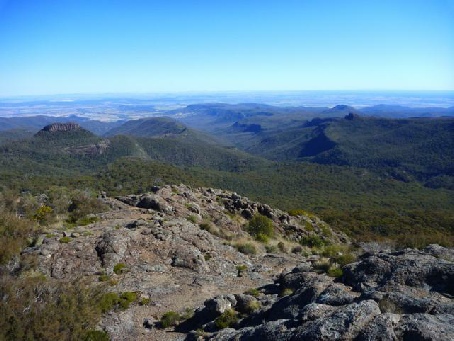

Mt Kaputar National Park

Mount Kaputar National Park
Be awed by towering forests, breathtaking rock formations and stunning scenery at Mount Kaputar National Park. Roughly one hours drive from Narrabri in northern NSW, Mount Kaputar is an explorer’s paradise.
Take in the views from the park’s lookouts, have a relaxing picnic or barbecue, or stay overnight in a picturesque campground or cabin accommodation. Bring your binoculars to enjoy bird watching, or to search for possums and greater gliders after dark. Or for a more adventurous trip; walk one of the park's many tracks, or go for a mountain bike or horse ride through the spectacular landscape.
Landscape and Geology
How the park's landscape was formed
Twenty-
When we think of volcanoes, we tend to imagine the typical cone shape blasting ash and rock into the air. The Nandewar volcano was different: a shield volcano with gently sloping sides rising to a height of over 2100 m, 50 kilometres wide and erupting over 400 cubic kilometres of lava.
Nandewar's lava flows consisted of interspersed layers and various intrusions of basalt and another lava type, trachyte. Trachyte is harder than the surrounding rock. Over time, various layers of lava have eroded at different rates, producing a great variety of dramatic landscape features.
Although still impressive, the volcanoes we see now are dwarfs compared to the giants they were before the touch of time. Today, the Nandewar volcano is barely recognisable. Seventeen million years of wind, rain and ice have fashioned the vast volcanic dome to reveal the magnificent landscape now preserved as Mt Kaputar National Park.
Interesting features in the park
As you wander through the park's majestic forests, it's hard to imagine that this was once a deadly place bereft of life. The story of Kaputar and everything you see there today is inextricably linked to volcanoes. Such a past lends itself to a landscape dominated by deep narrow valleys, steep ridges and cliff-
The highest point in the park is Mt Kaputar itself, at 1510m above sea level (ASL). Twelve other named peaks exceed the winter snowline of 1200m ASL. Narrabri by contrast, located on the very edge of the Western Plains, is just 230m ASL.
Most of the walks and look-
Kaputar Plateau, Mount Dowe, Mount Grattai and Lindsay Rock Tops are all excellent examples of ancient trachyte lava terraces.
In other places, the lava terraces have been carved up by erosion, leaving behind flat-
One of the most prominent peaks in central Kaputar is the solitary shape of Ningadhun, which is a remnant of a much larger flow of trachyte lava that has been cut away and left isolated. Ningadhun stands beside the dramatic shape of Mount Yulludunida, a feature known as a cone sheet with a complicated geological history.
A spectacular reminder of Kaputar's volcanic past is Sawn Rocks, one of the best examples of organ-
© State of New South Wales through the Office of Environment and Heritage
Click the link for more information about Mount Kaputar National Park
View from The Governor

Photos of Mount Kaputar National Park -
Photos of Mount Kaputar National Park -